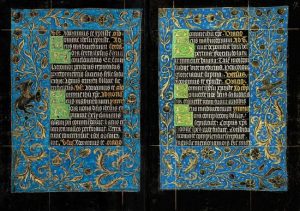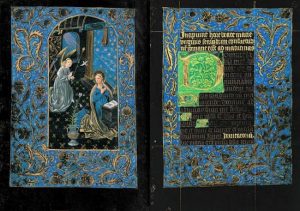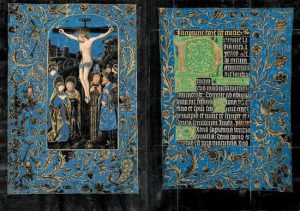Books of Hours, popularized in the late medieval period, were prayer books filled with psalms and litanies for one’s own devotion. These types of prayer books mirrored the books nuns and priests would utilize for their devotion and were organized to follow the canonical hours, which outlined the times one should pray. During the late 15th century these books helped to popularize prayers and biblical images. The Books of Hours were often commissioned by churches or those of wealth or nobility to be used for prayer, as well as, eloquent show pieces. The Book of Hours known as the Black Hours became popular due to its unique gothic style and vibrant illuminations. By analyzing the material of the manuscript such as text, pigment, and binding one can discover a deeper understanding of the social standing, religion, and education of its commissioner.
The Black Hours was originally created from black dyed vellum. Vellum, made from calf skin, provided an ideal medium for the rich blue, gold, and silver colors the manuscript employs. The blue and black borders run along all edges of the page and house designs of vines, flowers, as well as, medieval beasts. The print is written in white ink and centered on the middle of the page against the overarching colored borders. The historiated or enlarged initial found the beginnings of each prayers are colored in a pastel green, a unique shade for the time, as most greens were deep and rich.

The rarity of these vibrant pigments as well as the black vellum, and gold and silver leafing emphasize the opulence of the manuscript, but also speaks volumes for the status of its commissioner. The detail and choice of material reveal the commissioner must have been a devout Catholic, wealthy, and literate to have funded such an ornate book of hours. In addition, when analyzing the text one can identify it is in Latin, which serves as further evidence of the manuscript’s commissioner’s educated status. The manuscript also only has about 14 full page sized miniatures, which reinforces the idea that one would be able to read the prayers and use the images as an accompaniment, rather than just relaying on the illuminations to understand the passages. A manuscript made with this detail and richness was likely made for only this privileged family, therefore one should be wary in assuming the majority of people had manuscripts such as this one readily available.
This specific manuscript is around 170 by 120 mm, meaning it was most likely made for residential use and not a church. During this period, churches commissioned bibles to be made large as center pieces; these pieces often had many illuminations to be accessible to the general illiterate population. A prayer book, however was a more intimate experience, unlike a bible in a church it was meant for one person to be reading it at a time. The intimacy of the prayer book also helped solidify the trend of the individual relationship with God that began to rise at the time. This is evident as even scenes in prayer books depicted their characters reading from their own prayer books. For example, in folio 29v, Virgin Mary is depicted reading a book similar to the Black Hours when she is visited by an angel. Spirituality also became more popular, which further highlights how people began to experience religion more individually (Britannica). 
At the time, not only was textual production a feat, it was an opportunity only the wealthy and religious affiliated had the pleasure of indulging in (Treharne 25). A manuscript would need to employ several people to write, illuminate, and rubricate the piece. Illuminations specifically took a significant amount of skill, technique, and time to make. Therefore, many illuminations focused on the most significant biblical events. Much of the artistic work is in the Black Hours depict pivotal moments of Christ’s life, such as his birth and crucifixion. Christ’s crucifixion in folio 14v is one of the most famous images as he is surrounded by St. John and Mary as well as a crowd of other seemingly murmuring around Christ’s body. The importance of this  scene is characterized as it is the first page that follows the religious calendar. It also serves as a reminder of Jesus sacrifice, which in turn would motivate one’s reason to worship and utilize the prayer book. Other keynote biblical events such as the Massacre of the Innocents and the Annunciation to the Sheperds are emphasized by the ornate illustrations. Scenes such as these were broken down into illustrations that were easier to interpret and interact with when praying.
scene is characterized as it is the first page that follows the religious calendar. It also serves as a reminder of Jesus sacrifice, which in turn would motivate one’s reason to worship and utilize the prayer book. Other keynote biblical events such as the Massacre of the Innocents and the Annunciation to the Sheperds are emphasized by the ornate illustrations. Scenes such as these were broken down into illustrations that were easier to interpret and interact with when praying.
Manuscripts in their material, and writing helped to showcase the wealth, religion, and status of the individual or community commissioning the it. The Black Hours manuscript size, color, vibrancy, and illuminations speak to its purpose as a prayer book and emphasize the prestige of its owners.
Works cited:
McKenzie, John L., et al. “Roman Catholicism.” Encyclopædia Britannica, Encyclopædia Britannica, Inc., 19 July 2017, www.britannica.com/topic/Roman-Catholicism#toc257691.
Tory, Geoffroy 1480-1533 “Book of Hours.” WDL RSS, Library of Congress, 1 Jan. 1970, www.wdl.org/en/item/354/.
Treharne, Elaine M. Medieval Literature: a Very Short Introduction. Oxford University Press, 2015.